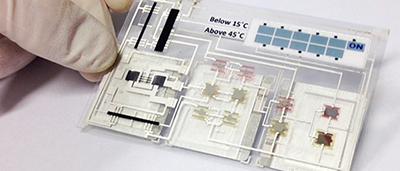Thinfilm Builds Stand-Alone Smart Sensor Label
- Published: January 21, 2014
OSLO, NORWAY | Thin Film Electronics ASA reports that it has successfully demonstrated its first fully functional, stand-alone Smart Sensor Label. The temperature-tracking label, designed for monitoring of perishable goods, demonstrates a complete closed system built from printed and organic electronics.

The temperature monitoring market is predicted to reach over $3.2 billion USD by 2020. Growing at 9% annually, the market is driven by a global need to reduce waste and improve safety of perishable goods. For example, Thinfilm’s Smart Label will help pharmaceutical companies keep temperature-sensitive products safe and effective, while preventing the unnecessary destruction of usable products. Retailers using temperature-monitoring labels during shipment of produce and other food products will have immediate insight with regards to both shelf life and food safety.
Davor Sutija, Thinfilm CEO, explains why temperature monitoring is just the beginning. “The integration of memory and logic creates an extensible platform, on which we will be able to create a wide variety of low-cost electronics in a label format. Printing provides scale and cost advantages that cannot be matched by any other electronic technology. With our customers, we are delivering the ubiquitous intelligence necessary to turn the Internet of Things into the Internet of Everything.”
The system announced today is the first demonstration of a stand-alone, integrated printed electronic system powered solely by batteries. According to Christer Karlsson, Thinfilm CTO, “A key breakthrough for this demo was the low-voltage complementary logic we announced in June [2013]. Polyera and our other materials partners have played an essential role in helping us move products forward.”
In the system, organic logic detects that a critical temperature threshold has been exceeded and signals the display driver to turn on a segmented display. Prior important technical milestones include:
- Low-voltage display driver based on complementary organic logic (June 2013)
- Memory write based on detection of temperature thresholds (December 2012)
- Full addressing logic for multi-bit read-write of printed memory (October 2011)
Thinfilm has now demonstrated all components necessary to produce its first system products by end of 2014.












